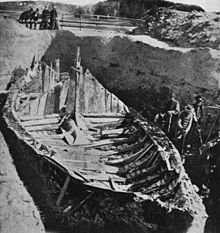Gokstad ship
The Gokstad ship is a late 9th century Viking ship found in a ship burial beneath a burial mound at Gokstad farm in Sandar, Sandefjord, Vestfold, Norway. It was excavated in 1880 by Nicolay Nicolaysen.

The ship
The Gokstad ship is clinker-built, constructed largely of oak. The ship is 24 m long and 5 m wide. It is the largest in the Viking Ship Museum in Oslo. The ship was built to carry 32 oarsmen, and the oar holes could be hatched down when the ship was under sail. It's utilized a square sail of c. 110 square meters, which, it is estimated, could propel the ship to over 12 knots. While the ship was traveling in shallow water, the rudder could be raised.
Dendrochronological dating suggests that the ship was built of timber that was felled around 890 AD.
The ship's design has been demonstrated to be very seaworthy. A replica of the ship crossed the Atlantic from Bergen, Norway to be exhibited at the World's Columbian Exposition, Chicago, in 1893. Other known replicas include the Gaia, which currently has Sandefjord as its home port, and the Munin, (a half scale replica) located in Vancouver, BC.

The skeletal remains
During the excavations, the skeleton of a male aged between 50-70 years was recovered. The skeleton was found in a bed inside a timber-built burial chamber. Although the identity of the person buried is unknown, it has been suggested that it is that of Olaf Geirstad-Alf, a petty king of Vestfold. He was of the House of Yngling, and died about this time, according to the Heimskringla.
The grave goods
The grave was furnished with grave goods. Apart from the ship itself, they consisted of three small boats, a tent, a sledge and riding equipment. It is believed that the mound was plundered in ancient times. The excavation in 1880 showed that valuables of gold and silver had been removed. In the Viking period, weapons were considered an important part of a man's grave goods. In the case of the Gokstad ship, any such weapons were probably taken by grave robbers.

Currently, the ship, the reconstructed burial chamber, two of the small boats and two tent boards from the burial chamber are displayed in the Viking Ship Museum in Oslo. Some other artifacts that survived the plundering are also on display in the museum.
See also
References
Christensen, A.E. Ingstad, A.S. and Myhre, B. (1992) "Osebergdronningens Grav", Oslo
